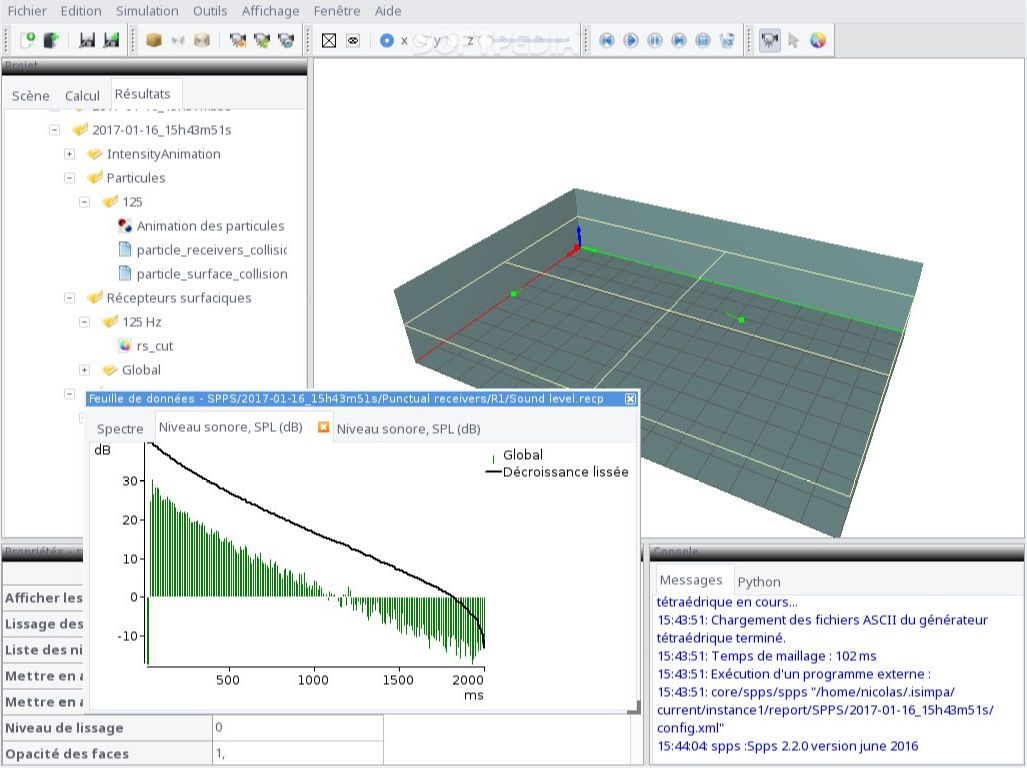
I-Simpa
1.3.4Study the sound propagation in complex geometrical domains with the help of this interesting and complex 3D acoustics modelling software
Designed by the professionals at IFSTTAR (short for French Institute of Science and Technology for Transport, Development and Networks), I-Simpa is an open-source 3D acoustics modeler.
It’s designed primarily to take on the role of a room acoustic software, and it’s capable of providing researchers a good idea of how the sound waves propagate in most 3D complex domains.
Right off the bat, what’s most impressive about this utility is the sheer number of real-life applications it has. For example, it can be used by acousticians to study the acoustics of any room, as well as industrial halls, industrial spaces, urban-related spaces, as well as other, more complex 3D environments such as the interiors of vehicles, or various nature-made cavities.
This makes the app very suited for research, engineering, and can even pose important education purposes. The application bundles two types of coding patterns: the TCR – based on the classical theory of reverberation and the SPPS – base don particle tracing approach.
I-Simpa allows anyone to import 3D files with some of the most common formats such as 3DS, STL, PLY, and POLY. It has a series of automatic tools used to correct the model during the file importation and an algorithm for model approximation by the marching cube method.
It also allows researchers to important sound data from CATT-Acoustic and Odeon, both two renowned room acoustic software. I-Simpa also provides all the required tools to help users define acoustic parameters by frequency band such as absorption, transmission, loss, scattering.
The same level of complexity is offered regarding sound sources (spectrum, position, directivity, delay, and so forth), acoustic receivers, and acoustic calculation.
Interest parties can check out the app’s features alongside a short presentation of the GUI, and a few useful tutorials on the official Wiki.
It’s designed primarily to take on the role of a room acoustic software, and it’s capable of providing researchers a good idea of how the sound waves propagate in most 3D complex domains.
Right off the bat, what’s most impressive about this utility is the sheer number of real-life applications it has. For example, it can be used by acousticians to study the acoustics of any room, as well as industrial halls, industrial spaces, urban-related spaces, as well as other, more complex 3D environments such as the interiors of vehicles, or various nature-made cavities.
This makes the app very suited for research, engineering, and can even pose important education purposes. The application bundles two types of coding patterns: the TCR – based on the classical theory of reverberation and the SPPS – base don particle tracing approach.
I-Simpa allows anyone to import 3D files with some of the most common formats such as 3DS, STL, PLY, and POLY. It has a series of automatic tools used to correct the model during the file importation and an algorithm for model approximation by the marching cube method.
It also allows researchers to important sound data from CATT-Acoustic and Odeon, both two renowned room acoustic software. I-Simpa also provides all the required tools to help users define acoustic parameters by frequency band such as absorption, transmission, loss, scattering.
The same level of complexity is offered regarding sound sources (spectrum, position, directivity, delay, and so forth), acoustic receivers, and acoustic calculation.
Interest parties can check out the app’s features alongside a short presentation of the GUI, and a few useful tutorials on the official Wiki.
65.3 MB
Info
Update Date
Dec 23 2020
Version
1.3.4
License
GPLv3
Created By
IFSTTAR
Related software CAD







